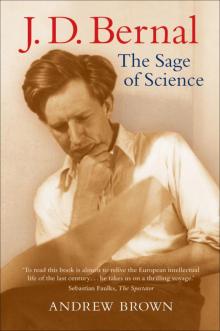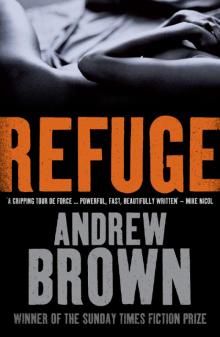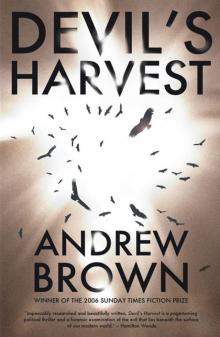- Home
- Andrew Brown
J D Bernal
J D Bernal Read online
J. D. BERNAL
For Tom Shields
and
In memory of my parents
J. D. Bernal
The Sage of Science
ANDREW BROWN
Great Clarendon Street, Oxford OX2 6DP
Oxford University Press is a department of the University of Oxford. It furthers the University’s objective of excellence in research, scholarship, and education by publishing worldwide in
Oxford New York
Auckland Cape Town Dar es Salaam Hong Kong Karachi Kuala Lumpur Madrid Melbourne Mexico City Nairobi New Delhi Shanghai Taipei Toronto
With offices in
Argentina Austria Brazil Chile Czech Republic France Greece Guatemala Hungary Italy Japan Poland Portugal Singapore South Korea Switzerland Thailand Turkey Ukraine Vietnam
Oxford is a registered trade mark of Oxford University Press in the UK and in certain other countries
Published in the United States
by Oxford University Press Inc., New York
©Andrew Brown 2005
The moral rights of the author have been asserted
Database right Oxford University Press (maker)
First published 2005
All rights reserved. No part of this publication may be reproduced, stored in a retrieval system, or transmitted, in any form or by any means, without the prior permission in writing of Oxford University Press, or as expressly permitted by law, or under terms agreed with the appropriate reprographics rights organization. Enquiries concerning reproduction outside the scope of the above should be sent to the Rights Department, Oxford University Press, at the address above
You must not circulate this book in any other binding or cover and you must impose the same condition on any acquirer
British Library Cataloguing in Publication Data
Data available
Library of Congress Cataloging in Publication Data
Data available
Typeset by SPI Publisher Services, Pondicherry, India
Printed in Great Britain
on acid-free paper by
Clays Ltd., St. Ives plc
ISBN 0–19–851544–8 978–0–19–851544–9
1 3 5 7 9 10 8 6 4 2
Contents
Acknowledgements
List of Illustrations
Abbreviations
1. A Long Way to Go
2. Cambridge Undergraduate
3. Bohemian Crystallographer
4. Science Fantasy
5. The New Kingdom
6. Soviet Pilgrims
7. The Shadow of the Hawk’s Wings
8. The Entertainment of the Scientist
9. Scientist at War
10. Bombing Strategy
11. Combined Operations
12. Overlord
13. Lessons of War
14. Rebuilding
15. Central Dogma
16. Peace at Any Price?
17. The Physical Basis of Life
18. History and the Origins of Life
19. Marxist Envoy
20. Peacebroking
21. Order and Disorder
22. Years of Struggle
Postscript
Notes
Index
Acknowledgements
For the past five years I have led the double life of a biographer, and Desmond Bernal (Sage) has proved to be the most engrossing and stimulating of companions. I was fortunate to be able to interview many of his friends and distinguished colleagues. Readers will discover that his domestic arrangements were unconventional, and my first thanks are to Jane and Martin Bernal for supplying family information. Martin’s mother, Margaret Gardiner, who was then in her late nineties and still occupying the house that was such a lively venue for intellectuals in the 1930s, was mystified that Des was going to join her other close friends, W.H. Auden, Barbara Hepworth, and Solly Zuckerman as a biographical subject. She gave me good-humoured advice on traps to avoid, before describing with chilling detail the visit to the USSR in 1934 and the threatening atmosphere, to which Bernal seemed impervious.
Bernal’s greatest legacy was the next generation of scientists that he inspired to extend the many trails he started. Max Perutz, who said that Bernal was the most fascinating talker he ever encountered, described Bernal’s lab at Cambridge as though he had first set foot in it a few weeks (rather than 65 years) earlier. He explained some of the technical aspects of X-ray crystallography with such lucidity that the hair stood up on the back of my neck, and I glimpsed the amazing world of three-dimensional symmetry and reciprocal space. Perutz referred to Dorothy Hodgkin (another Bernal protégée) as having saintly qualities: after he described the twenty-five years of utter frustration he endured before beginning to unravel the structure of haemoglobin, I formed the impression that saintliness was a prerequisite in crystallography – at least until the advent of automation. Sir Aaron Klug left me in no doubt about the brilliance of Bernal as an experimenter and his stature as one of the founding fathers of molecular biology. His account of the groundbreaking research into the structure of viruses, begun at Birkbeck with Rosalind Franklin, was revelatory. Klug and Alan Mackay both recalled the hazards and squalor of the labs at Birkbeck during the 1950s, and Bernal’s strengths and weaknesses as a director. Alan, who is a true disciple of Bernal’s in his approach to the history of science and its social implications, has been a bountiful source of obscure articles and of contacts around the world. John Finney helped me to understand Bernal’s contributions to the structure of liquids.
Bernal was one of the crucial British ‘boffins’, who contributed so much in World War Two. During the war, with Solly Zuckerman and others, he extended the nascent field of operational research to study the effects of bombing on cities. Brenda Swann (Ryerson) and Renée Brittan were firsthand witnesses to those efforts. Sage’s pièce de résistance was the planning of D-Day – a contribution that has given rise to some controversy. I was extremely fortunate to track down Major-General Logan Scott-Bowden, who heroically tested Bernal’s hypotheses about the nature of the Normandy beaches in the months prior to the invasion. His early morning phone call was the most vivid account of the landings I have ever heard or read.
In addition to those already mentioned, I would like to thank the following, who knew Bernal and generously provided information: Paul Barnes, Gofty Bernal, Mike Bernal, Andrew Booth, Hugh Bunting, Ian Cherry, Francis Crick, John Finch, Ully Harris, Ken Holmes, Olga Kennard, John Kerridge, Stan Lenton, Andrew Malleson, John Mason, Vivien Pixner, Romila Thapar, Peter Trent, Norman Waddleton, James D. Watson and Maurice Wilkins. With the passing of the years, some of these remarkable people are, alas, no longer alive.
The raw material for this book mostly came from the Bernal archive in Cambridge University Library, where I was well served by Godfrey Waller and his staff. Here are the unpublished letters, diaries and travelogues that show Bernal consumed with the stuff of life from the atomic level to global politics. One unpublished note contains Bernal’s beautiful inductive argument for the replication of genetic material being essentially a linear process at the critical instant – an insight that would occur to Crick more than two decades later, when, as he wrote to me, he knew a lot more about proteins than Sage did in 1931. Although there are still six boxes of Sage’s love letters sealed until 2021, there were enough indiscretions in his early diaries to reflect his libidinous ways. As president of the World Peace Council, Bernal’s papers reveal a genuine personal relationship with Khrushchev. I will deposit transcripts of my interviews in the Bernal archive for the use of future historians.
In addition to the Cambridge University collection, I obtained valuable material from the American Institute of Physics, Birkbeck College London, Emmanuel Colle
ge Cambridge, the Harvard University libraries, the archives of Dorothy Hodgkin and John Kendrew at the Bodleian Library Oxford, the Mountbatten papers in the Hartley Library at the University of Southampton, the Ava Helen and Linus Pauling Archive at Oregon State University, the National Portrait Gallery, the Public Record Office at Kew, the Royal Society, and the Zuckerman Archives at the University of East Anglia. I am extremely grateful to the archivists and librarians in all these places, who were uniformly generous in their cooperation and spent considerable time hunting down small items for me, sometimes in response to whimsical email requests. I am indebted to all the above institutions for their permission to publish various letters and photographs.
Lorna Arnold proved to be the most alert, encouraging and informed listener. John Ballantyne and Michael St. Clair read and provided improving comments on every chapter (many of which were patiently scrutinized by the scientists involved). Others who helped in myriad ways include Will Bernal, Giovanna Bloor, Frank Bunn, Tim and Celia Charlton, Jeremy Karl Cock-croft, Neal Desjardins, Jeremy Elston, Sebastian Faulks, Istvan Hargittai, Graham and Betty Hines, Luke and Stephanie Hughes-Davies, Bruce Kupelnick, Julian Lewis, Victor Mcelheny, Robert Olby, John Streather, and numerous medical colleagues in New Hampshire. I have an uneasy feeling that I have forgotten someone important, in which case I apologize now.
At Oxford University Press, the book was commissioned by Susan Harrison. Susan was succeeded by Michael Rodgers, before I eventually arrived at the overflowing desk of Latha Menon. She imposed a needed deadline and then applied her justly celebrated editorial touch to the manuscript. My thanks to her, James Thompson, Deborah Protheroe, Mike Nugent, Rachel Woodforde and all the other OUP staff who have brought the book to fruition. My thanks are also due to David Carles, and to Anne Holmes and Rob Rudnick for the index. Any remaining errors remain the sole property of the author.
Lastly, this biography would not have been started or finished without the love, patience and cooking of Jane Ballantyne MD.
List of Illustrations
1. Desmond’s father and mother.
Courtesy of Dr William Bernal
2. The Bernal children with their nurse, Daisy, and either Bessie or Aunt Cuddie in 1908.
Courtesy of Jane Bernal
3. The eighty freshmen of Emmanuel College Cambridge, October 1919.
Courtesy of the Master and Fellows of Emmanuel College, Cambridge
4. Sage and his wife, Eileen Bernal.
Courtesy of Dr Mike Bernal
5. Patrick Blackett as an Acting Lieutenant in the First World War.
Royal Society
6. Sage, Sylvia Dickinson, Isidore Fankuchen, and H.D. Dickinson at a British Association Meeting, Nottingham 1937.
AIP Emilio Segrè Visual Archives, Fankuchen Collection
7. W.T. ‘Bill’ Astbury (1898–1961).
© Godfrey Argent Studio/Royal Society
8. Max Perutz (1914–2002), who joined Bernal’s lab in 1936.
© Cavendish Laboratory Cambridge
9. Bernal with Margaret Gardiner in the Alps, 1936.
Courtesy of Dr William Bernal
10. Dorothy Hodgkin looks on as Sage demonstrates Tobacco Mosaic Virus gel to Irving Langmuir at British Association Meeting, Nottingham 1937.
11. Dorothy Wrinch (1894–1976).
C.H. Waddington, courtesy of Gary Werskey
12. Geoffrey Nathaniel Pyke (1894–1948), the begetter of Habbakuk.
13. A subdued Solly Zuckerman surveys damage in Tobruk harbour in February 1943.
Courtesy of the Zuckerman Archives, University of East Anglia
14. Photo-reconnaissance of a D-Day beach.
Public Record Office (HS8/286)
15. Beach on D-Day+1 with vehicles stuck ‘like flies in amber’.
Public Record Office (HS8/286)
16. Sage in ‘the very doubtful disguise of a naval officer’ for his aborted second visit to the Normandy beaches.
Bernal Archive, by permission of the Syndics of Cambridge University Library
17. Sage in Ceylon 1944 next to Lord Mountbatten.
18. The Birkbeck crystallography research group in the Faraday Lab at the Royal Institution in 1946.
Bernal Archive, by permission of the Syndics of Cambridge University Library
19. Sage meets Comrade Lysenko in 1949.
20. Margot Heinemann.
Courtesy of Jane Bernal
21. 21–22 Torrington Square just before the houses were demolished in 1966.
By permission of the Syndics of Cambridge University Library
22. Sage with Nobel laureates Irène and Frédéric Joliot-Curie and Sir C.V. Raman in India, 1950.
23. Leading virus crystallographers at a conference in Madrid, 1956.
Courtesy of Professor D.L.D. Caspar
24. Sage and Linus Pauling in Moscow in 1957 for Oparin’s conference on the origins of life.
Linus Pauling Archive, University of Oregon State
25. Jane Bernal holds her parents’ hands as they march in support of the London bus strike, June 1958.
Courtesy of Jane Bernal
26. Bernal listens as Khrushchev addresses the World Congress on General Disarmament and Peace in Moscow, July 1962.
27. Sage constructs his first ball-and-spoke model of liquid structure.
Courtesy of Jane Bernal
Abbreviations
Abbreviations abound in military planning, science and ad hoc socialist politics, and were therefore unavoidable in writing about Bernal.
ARC
Agricultural Research Council
ARP
Air-Raid Precautions
AScW
Association of Scientific Workers
BAAS
British Association for the Advancement of Science
BRS
Building Research Station
CAS
Chief of the Air Staff
CCO
Chief of Combined Operations
CIGS
Chief of Imperial General Staff
CND
Campaign for Nuclear Disarmament
CO
Combined Operations
COHQ
Combined Operations Headquarters
COS
Chiefs of Staff
COSSAC
Chiefs of Staff Supreme Allied Command
CPGB
Communist Party of Great Britain
CSAWG
Cambridge Scientists Anti-War Group
CUSS
Cambridge University Socialist Society
DNA
Deoxyribonucleic acid
DSIR
Department of Scientific and Industrial Research
FAS
Federation of American Scientists
FIL
For Intellectual Liberty
FRS
Fellow of the Royal Society
HE
High Explosive
ICBM
Inter-Continental Ballistic Missile
ICDP
International Confederation for Disarmament and Peace
IRA
Irish Republican Army
IRD
Information Research Department
IUCr
International Union of Crystallography
JTWC
Joint Technical Warfare Committee
MP
Member of Parliament
MRC
Medical Research Council
MTB
Motor Torpedo Boat
OR
Operational Research
RAF
Royal Air Force
RF
Rockefeller Foundation
RI
Royal Institution
RNA
Ribonucleic acid
SAC
Supreme Allied Commander
SACSEA
Supreme Allied Commander South-East Asia
SANE
Na
tional Committee for a Sane Nuclear Policy
SEAC
South-East Asia Command
SHAEF
Supreme Headquarters Allied Expeditionary Force
TBSV
Tomato Bushy Stunt Virus
TIS
Theatre Intelligence Section
TMV
Tobacco Mosaic Virus
TUC
Trades Union Congress
UNESCO
United Nations Educational, Scientific and Cultural Organization
UXB
Unexploded Bomb
WPC
World Peace Council
WFSW
World Federation of Scientific Workers
1
A Long Way to Go
The newest and grandest liner in the White Star fleet, Celtic, sailed from Queenstown harbour without fanfare. She cut through the grey waves, rounding the Head of Kinsale as the late November sun slipped beneath the Atlantic Ocean. The coastline of southern Ireland became a faint black line, and the little boy who had been watching it intently turned to his mother and inquired, ‘Mammy, we will go back now?’ She replied, in French, ‘No, Desmond, they must go on to America, they won’t turn back now.’ ‘Not even for you, Mammy?’1
Unlike most of the passengers, Elizabeth Bernal was not sailing away to seek a life in the New World. Her own mother, who was born into a landowning Protestant family in County Antrim, had been taken to the United States as a child. She subsequently met and married a man in the small town of Knoxville, Illinois, but was soon widowed. The local Presbyterian minister, the Reverend William Young Miller, whose family came from New England, befriended her, and they married. Elizabeth (Bessie), one of their six children, was born in 1869. When her father retired from the ministry in 1883, he moved the family west to the new city of San Jose in California.2 Bessie and her sister, Laetitia, were sent to Mme Bovet’s Academy for young ladies in New Orleans for the type of refined education that was not available in the rugged West. Both were good students and Bessie excelled at languages. By extraordinary good fortune, the Californian railway magnate and US Senator, Leland Stanford, founded his university just a short buggy ride from San Jose. When its doors first opened in 1891, women were admitted, and Bessie enrolled there for lectures the following year.3 She did not complete a degree course, but instead made the Grand Tour of Europe with Laetitia, concentrating on the great centres of Renaissance art in Italy as well as visiting Germany and France. Bessie strengthened her French by studying at the Sorbonne, but she continued to speak it with a twanging New Orleans accent.

 J D Bernal
J D Bernal Refuge
Refuge Devil’s Harvest
Devil’s Harvest